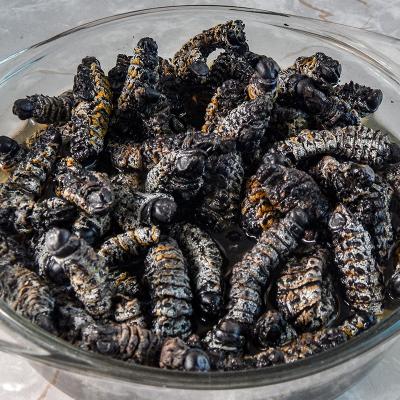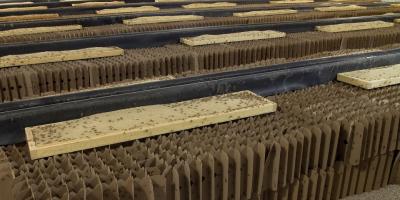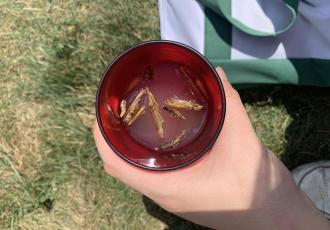Many people have gone vegetarian or vegan to reduce their environmental impact – but have you considered eating insects instead?
By 4th-year student Megan Young
A buzz around Grounds is a lively conversation about sustainable food systems. In its 2030 Sustainability Plan, the University committed to increasing sustainable food purchases to 30% of the annual total by 2030. In efforts to achieve this goal, the Office for Sustainability supports three primary focus areas: Morven Kitchen Garden, the Student Garden, and the Sustainable Food Collaborative. These three initiatives aim to increase the amount of food consumed on Grounds that is produced locally and in a sustainable, equitable manner.
Much of the conversation about sustainable food involves transportation costs, production without the use of chemicals, and fostering soil fertility and overall ecological health. An intriguing addition to this framework is the cultivation and dietary incorporation of insects. Yes, insects. What most people refer to as creepy crawlies may provide an answer to some of the impending challenges of implementing a sustainable food system.
Entomophagy is the practice of eating insects. While insects are not currently staples of Western cuisine, they currently supplement the diets of nearly 2 billion people worldwide. In Zimbabwe, people eat the Mopane worm (Gonimbrasia belina), which is the caterpillar of the Emperor moth. People cook this caterpillar in a variety of ways from a meat substitute in soups and stews to a crunchy chip to a ground-up powder added as a spice to sauces.
In Oaxaca, Mexico, you can buy chapulines at local sporting events. Chapulines are grasshoppers of the genus Sphenarium that are often toasted and served with a seasoning of chile and lime. Across Southeast Asia, especially in Thailand, people consume palm weevils (Rhynchophorus ferrugineus), a species of beetle. Palm weevil larvae have an incredibly high nutritional content with twice the average zinc content of beef per serving as well as high amounts of protein and healthy fats. Weevil larvae can be eaten fried, roasted, or raw, and as they are 10-30% fat, they don’t need oil to cook and will instead carmelize in their own juices. The palm weevil in particular holds the promise of expanded cultivation as they can be raised in large numbers fairly easily using palm tree branches and plastic tubes.
So why should we increase the scale at which insects are consumed? Feeding a growing world population will necessarily require an increase in food production, which is already placing a heavy pressure on limited resources. In 2013, the United Nations Food and Agriculture Organization (FAO) released a report encouraging the consumption of insects as food as a way to ensure protein availability. The report detailed three key areas of benefit of the consumption of insects: health, environmental and economic.
Health: Insects are a highly nutritious and healthy food source. While the exact amounts of each macronutrient are variable between species and metamorphic stages, they contain high levels of protein, fiber, fats and minerals. Often, adult insects contain higher protein content while larval stages contain higher amounts of fat.
Environmental: Insects have a high feed conversion efficiency, an animal’s capacity to convert feed mass into increased body mass. For instance, crickets require only 2 kilograms of feed for every 1 kilogram of bodyweight gain. Additionally, insects require both less land and water to farm than traditional animal proteins, like cattle, pigs and even poultry. The cultivation of insects emits relatively few greenhouse gasses and relatively little ammonia. They can be reared on biological waste products such as food scraps, which reduces environmental contamination while adding value to waste.
Economic: The cultivation of insects is a low-tech and low-capital investment that offers relatively easy entry into the industry. There is a vast potential for insect farming at a small-scale in both urban and rural environments as it requires minimal space, can generate cash inflow in a short period, is relatively easy to manage, and converts feed to protein efficiently.
Entomo Farms, a company located in Ontario, Canada, has taken on the Food and Agriculture Organization’s mission by striving to make cricket-based food the first choice for individuals interested in high-quality, sustainable protein. As a member of a new industry, Entomo Farms has had to innovate along the way, including their methods of farming. Previously, most cricket farming occurred in bins that had to be opened regularly to feed the crickets. However, Entomo developed large rooms where crickets essentially roam “free range” with constant access to food and water. This new approach lowered labor costs and improved efficiency on a larger scale; the company can now produce over 2000 pounds of cricket per room. Additionally, Entomo Farms has learned that cricket “frass,” a combination of their waste and exoskeleton sheddings, is a dry, odorless, organic fertilizer that has enabled the implementation of a near zero waste system, in which they use the frass to grow the plants to feed the crickets.
As people search to create new food sources for the future, sometimes looking at what is already around us could provide the key. While insect consumption may not solve all of our sustainable food issues, the topic proves an increasingly relevant issue in the 21st century as we continue to experience the rising costs of animal protein, the spread of food insecurity due to environmental pressures and the increasing demand for protein due to global population growth.
If you are interested in learning more about the incorporation of insects into everyday diets across the globe, check out the following resources.
- Ologies Episode: “Entomophagy Anthropology (EATING BUGS AS SUSTAINABLE PROTEIN) with Julie Lesnik”
- The Gateway Bug → A documentary on the growing American edible insects industry and how Entomophagy offers countless advantages over traditional protein sources.
- Bugs On the Menu → A documentary examining entomophagy from the perspectives of cultural traditions in Latin America, Africa, and Southeast Asia.
Megan Young is a 4th-year student studying history and economics at UVA. She works in the Office for Sustainability with the Outreach team and is passionate about making sustainability a lifestyle achievable for all students and community members. She loves hiking, cooking, working with kids and reading.





